#kemetic icons
Explore tagged Tumblr posts
Text

Ptah, the Cosmocrator / Memphite Triad (WiP)
#pls don not steal nor repost#personal art#own art#kemetic icons#devotional art#devotional icons#ptah#sekhmet#nefertum#apis bull#primeval mound#memphis triad#memphite theology#egyptian polytheism#kemetic art#kemeticism#WiP#netjeru#netjer
82 notes
·
View notes
Text
Looking for three more people interested in joining the group order for one of my standing Wepwawet jackal bronzes. 😊
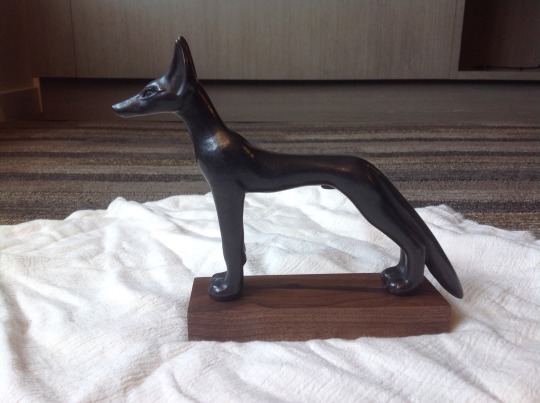
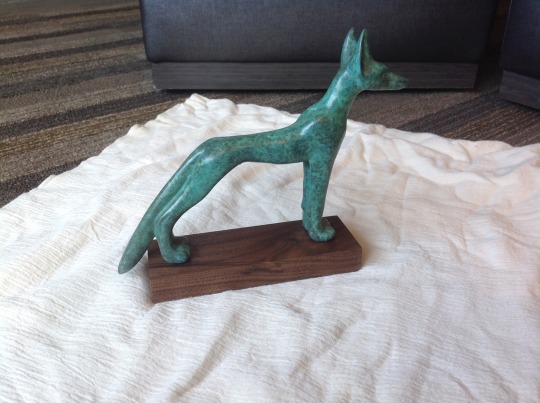
43 notes
·
View notes
Text

Why Black People Don’t Truly Respect and Care About Their Culture, Revolutionaries, Icons, History, and Ancestors: A Garveyite Perspective
From a Garveyite perspective, one of the greatest tragedies in the Black world is that many Black people claim to love their history, revolutionaries, and culture—but in practice, they neglect, betray, and abandon them. Instead of applying the teachings of our ancestors and leaders, many Black people:
Romanticize revolutionaries but ignore their real messages.
Celebrate Black culture superficially while prioritizing white cultural values.
Treat Black history as entertainment rather than a blueprint for liberation.
Seek white validation rather than investing in Black self-reliance.
Marcus Garvey understood this hypocrisy well. He witnessed millions of Black people chant his name, yet when it was time to sacrifice and invest in the Black Star Line and the UNIA, many failed to act. This same pattern repeats itself with every Black movement, revolutionary, and cultural legacy that has emerged.
This analysis will explore:
How slavery and colonialism conditioned Black people to devalue their own culture.
The betrayal of Black revolutionaries and why they are honoured only after death.
Why Black people prioritize white validation over Black self-reliance.
The failure to protect and preserve Black culture from white exploitation.
How Garveyism provides the solution for restoring true respect for Black history and leadership.
1. How Slavery and Colonialism Conditioned Black People to Devalue Their Own Culture
One of the biggest reasons Black people struggle to respect their own culture, revolutionaries, and history is because they were psychologically trained to despise their identity.
A. The Destruction of African Identity in Slavery and Colonialism
Enslaved Africans were stripped of their names, languages, and religions, making it easier for them to accept European cultural superiority.
Colonial education taught Black people that their history was inferior, while European history was glorified.
Black traditions, spiritual practices, and leadership systems were demonized as “pagan” and “uncivilized”, while white systems were forced upon Black nations.
Example: In most African and Caribbean countries today, European languages like English, French, and Portuguese are the official languages, rather than African languages. This is a psychological remnant of colonial rule.
B. Black People Were Taught to Glorify Their Oppressors
Black people were forced to worship European religious figures while rejecting their African gods, heroes, and traditions.
Even after slavery, many Black people were conditioned to see European institutions (schools, businesses, governments) as more legitimate than Black ones.
As a result, Black culture is only celebrated when it is “approved” by white society.
Example: African religions like Ifá, Vodun, and Kemetic spirituality are still labelled as “evil” in many Black communities, while Christianity (a tool of colonial oppression) is embraced without question.
Key Takeaway: Garveyism teaches that Black people must decolonize their minds and fully embrace their own culture, history, and leadership, rather than depending on white validation.
2. The Betrayal of Black Revolutionaries: Honoured Only After Death
Throughout history, Black revolutionaries have been rejected, ignored, or betrayed in their lifetimes—only to be glorified after they are gone.
A. Black Leaders Are Loved in Death, Hated in Life
Marcus Garvey was praised after his death, but during his lifetime, he was sabotaged by other Black leaders and abandoned by those who claimed to support him.
Malcolm X was rejected and isolated by many Black organizations before he was assassinated.
Dr. King was called an “enemy of the state” and murdered for his activism—yet today, white institutions pretend to celebrate him.
Example: Today, Malcolm X is a hero, but during his life, Black organizations distanced themselves from him because he was seen as “too radical.”
B. Why Black People Abandon Their Leaders in Their Time of Need
Many Black people are afraid to truly commit to revolutionary change because it requires sacrifice and risk.
When Black leaders face attack, imprisonment, or assassination, many of their own people refuse to stand with them.
Once a leader is dead and no longer a threat, people feel safe to honour them in words—but not in action.
Example: How many people today praise Assata Shakur and Huey P. Newton, but refuse to organize for the revolution they fought for?
Key Takeaway: If Black people truly respected their leaders, they would support them while they are alive, not just mourn them after they are gone.
3. Why Black People Prioritize White Validation Over Self-Reliance
Garvey warned that Black people will never be free if they continue seeking white approval instead of building their own power structures.
A. The Obsession with White Validation
Many Black people measure success by how much recognition they receive from white society rather than by how much they empower their own people.
Black artists, scholars, and activists are often ignored by their own communities until white institutions validate them.
Black businesses struggle because many Black people would rather spend their money in white-owned establishments than support their own.
Example: Black authors like Chinua Achebe and Toni Morrison were not widely celebrated until white institutions recognized them.
B. The Integration Trap: Seeking Acceptance Instead of Power
Instead of demanding Black control over education, economics, and governance, many Black people are content with assimilation into white institutions.
Integration destroyed Black communities by making them dependent on white-controlled systems rather than building their own.
Example: Before integration, Black communities had their own schools, businesses, and hospitals. After integration, many of these institutions disappeared because Black people preferred white-owned alternatives.
Key Takeaway: Garveyism teaches that true success is not white acceptance—it is Black control over Black destiny.
4. The Failure to Protect Black Culture from White Exploitation
Black culture is stolen, repackaged, and sold back to Black people—and many accept it without protest.
A. Black Culture Is Only Respected When White People Profit from It
Black music, fashion, and art are ignored until white people start embracing them.
Once white corporations profit from Black creativity, they erase the Black pioneers who started it.
Example: Rock & Roll was created by Black artists like Chuck Berry and Sister Rosetta Tharpe, but today, it is viewed as “white music.”
B. Black People Must Control Their Own Culture
Black communities must own their own media, art, and history, rather than allowing white corporations to define them.
Every other ethnic group protects its culture, while Black people often allow theirs to be exploited.
Example: Instead of white-owned Hollywood controlling Black stories, there should be Black-owned film industries producing African-centered narratives.
Key Takeaway: Garveyism demands that Black people own, control, and protect their cultural legacy instead of allowing it to be stolen.
5. The Garveyite Solution: How to Restore True Respect for Black Culture and Leadership
To truly respect our culture, history, and revolutionaries, Black people must:
Commit to Pan-Africanism – Work with global Black communities to build self-sufficient institutions.
Support Black leaders while they are alive – Not just celebrate them after they die.
Create and protect Black-owned industries – Own and control our own music, fashion, and storytelling.
Reject the need for white validation – Define success by Black empowerment, not white recognition.
Teach real Black history – Ensure every Black child knows our revolutionaries, heroes, and ancestors.
Final Takeaway: Respect for Black history is not just words or posts—it is action. If we truly honour our ancestors, we must finish the work they started.
Conclusion: The Time for Empty Praise Is Over
Garvey warned us: "A race without power and respect for its past will forever be enslaved."
If we TRULY care about our leaders, culture, and ancestors, we must build, protect, and honour their legacy through action.
The time for fake love is over. It’s time to finish what our revolutionaries started.
#black history#black people#blacktumblr#black#black tumblr#pan africanism#black conscious#africa#black power#black empowering#malcom x#marcus garvey#black revolutionaries#black history month#african diaspora#black diaspora#black community#reparations now#self determination#ancestors#Garveyite#Garveyism
48 notes
·
View notes
Text
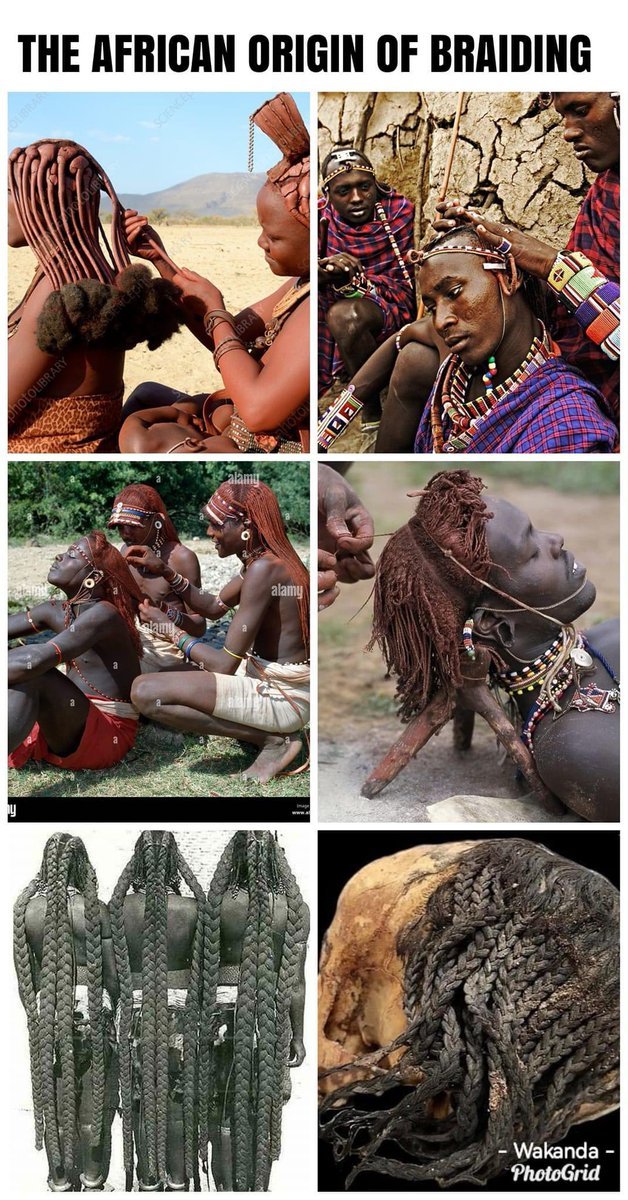
Typical African on Twitter
@Joe__Bassey
THE AFRICAN ORIGIN OF BRAIDING The origin of braids can be traced back 5000 years in African culture to 3500 BC—they were very popular among women. Braiding started in Africa with the Himba people of Namibia. The country’s Mbalantu ethnicity uses eembuvi braids as an initiation into womanhood – our first examples of single braids or “box braids". In Angola, among certain tribes, hair grooming was an activity trusted only by other family members — something that women were taught at a young age and encouraged to participate in throughout their lives to promote womanhood. The origins of the ever-popular Bantu Knots have been traced to the Bantu people who exist across central and Southern Africa. “South Africa’s “Zulu Knots” are said to be the original manifestation of the style, and South Africa is also credited for the invention of “Box braids”, with evidence of the style being traced back to 3500 BCE. Braiding’s roots in East Africa have been traced back to 3500 BC, with cornrows (called Kolese braids in Yoruba) maintaining the top spot in popularity for just as long. Historically, Somali women have been recorded donning long, small braids when approaching puberty. Ethiopia has maintained an admirably close relationship with its traditional forms of braiding. In the Southwestern Omo Valley, the Hamar people have perfected their hairstyles as a means to dictate male worth and female marital status. The importance of braids in communicating identity is a rich part of Uganda’s history, too. In Kenya, the Maasi and Kikuyu tribes have donned their famed matted braids, intricate beading, and gold detailings ever since. West Africa boasts an abundance of hair braiding styles, many of which have influenced global African culture and trends for decades. The Fula people, whose 30 million strong population exists across West Africa, gifted the world with Fulani braids. In Ghana, the iconic Banana or Ghana braids have gained favor for their easy application, upkeep, and excellence in providing protection to natural Black hair. The first examples of this way of braiding are traced back to hieroglyphics and sculptures found around 500 BC. Similarly, Nigeria’s rich history of braiding can be traced back to a clay sculpture dated to 500 BCE depicting a cornrowed member of the Nok tribe. Mali's Dogon people has various spiritual idols depicting cornrowed spiritual leaders, and the retained tradition of The Dama dance have allowed us the privilege of understanding the bewildering society that contributed to our understanding of our universe. In Sierra Leone, Mende people's hair is closely tied to femininity and is juxtaposed with the way forests grow out of the Earth – the vegetation covering Mother Earth grows skyward the way Afro-textured hair grows out of the head. Senegal’s Senegalese Twists or “Rao” as they’re known locally came in vogue as an alternative means of creating individual, long braids – if locs or “box braids” aren’t your style. Gambian warriors were known to march off to war with tightly coiled braids, too. The Mangbetu people of the Democratic Republic of Congo, known for their practice of wrapping their skulls into a cone shape from infancy, locally referred to as “Lipombo, ” the elongated heads were then adorned with braids plaited into a crowned, basket shape called edamburu. Cameroon’s bountiful Fulani community has kept many of their hair traditions well and alive, while the region’s Bantu population participated in the popularity of the now-famed ‘Bantu knots’. In Chad, women of the Basara ethnicity are known for their thick, long, luscious hair – often plaited into waist-long individual braids. In Kemet around 1600 BCE, hair braiding amongst women of royalty, nobility, and concubines was adorned with gold, beads, and perfumed grease, while common folk kept to simpler styles necessary to get work done. #Africa
13 notes
·
View notes
Text
Day 21 Sarcophagus
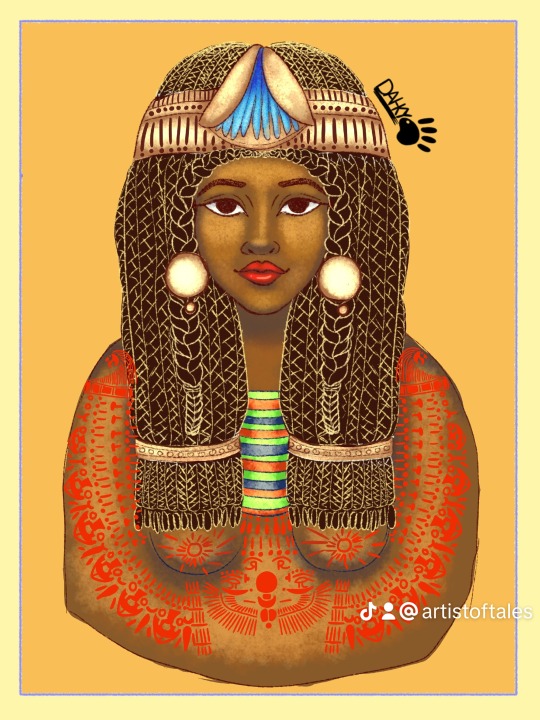

I did the sarcophagus of the "Chantress of Amun-Ra: Nehemes-Bastet". This one has the most detailed images and icons on her tomb, plus you can see Asaur, Heru, and Aset near the bottom. I only did half but I might do a full one later on. But she is stunning!
#sarcophagus #chantress #egyptianmythology #amunra #nehemesbastet #digitalart #akhtober #egyptian #deities #drawing #mythology #art #day21 #digitaldrawing #magic #pagan #witchcraft #illustration #simple #kemetic #firealpaca #artist #artistoninstagram #myart #dahkyarts #artistoftales #artistonig
#sarcophagus#chantress#egyptianmythology#amunra#nehemesbastet#digitalart#akhtober#egyptian#deities#drawing#mythology#art#day21#digitaldrawing#magic#pagan#witchcraft#illustration#simple#kemetic#firealpaca#artist#artistoninstagram#myart#dahkyarts#artistoftales#artistonig
17 notes
·
View notes
Text

someone in a Kemetic Discord server i'm in is sending me Nephthys headdress icon for free! they bought it off Etsy (i think?) and are just GIVING it to me!! i am so lucky. it'll be shipped on Monday.
2 notes
·
View notes
Text

Egypt bans Dutch archaeology team from Saqqara due to museum’s ‘Afrocentric’ exhibition
A team of archaeologists from a Dutch museum has been banned from carrying out excavations in Egypt’s rich Saqqara necropolis, after the museum mounted an exhibition that drew condemnation from Egyptian authorities.
After the opening of “Kemet: Egypt in Hip Hop, Jazz, Soul & Funk,” the National Museum of Antiquities (RMO) in Leiden received an email from the head of foreign missions of the Egyptian Antiquities Service saying that the museum is “falsifying history” with its “Afrocentric” approach, Dutch newspaper NRC reported on Monday.
Wim Weijland, the museum’s managing director, confirmed to CNN via email that the Egyptian authorities have denied the institution a permit for the next excavation season at Saqqara. He also confirmed that the journalist who wrote the NRC article had seen the email from the Egyptian authorities.
A vast burial ground that sits nearly 20 miles south of the capital Cairo, Saqqara is home to Egypt’s oldest pyramid, the pyramid of Djoser, and has been the site of multiple important discoveries in recent years.
The museum has been carrying out annual excavations there for more than 40 years. Its most recent excavation campaign took place earlier this year, between February 19 and March 23.
“The Rijksmuseum van Oudheden has been working at Saqqara since 1975,” Weijland told CNN. “For the upcoming season, the museum has been denied the permit to excavate here.”
Weijland said the reason for the permit’s denial is the “presumed ‘falsifying history’ in the current exhibition,” adding that the museum is trying to “open the dialogue” with the Egyptian authorities about the matter.
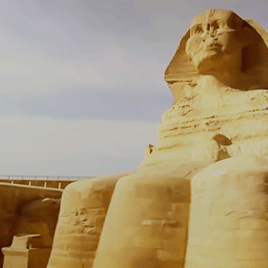
Mostafa Waziri, secretary-general of the Supreme Council of Antiquities of Egypt, did not respond to CNN’s request for comment.
Weijland went on to say that the aim of the “Kemet” exhibition is “to show and understand the depiction of ancient Egypt and the messages in music by African artists,” as well as to “show what scientific, Egyptological research can tell us about ancient Egypt and Nubia.”
Nubia is an ancient region in northeast Africa that extends from the Nile River valley in Egypt, all the way down to Khartoum in modern-day Sudan. The area was once home to the Nubian Kingdom of Kush, or the “African Pharaohs.”
According to its web page, the exhibition, which opened in April and runs until September 3, “embarks on a journey through music history” and looks at “the influence of ancient Egypt and Nubia…in the works of a multitude of musicians of African descent, including icons of jazz such as Miles Davis and Sun Ra and contemporary artists such as Beyoncé and Rihanna.”
In recent days, the museum’s social media posts about the exhibition were flooded with comments, mostly by Egyptians who deemed it disrespectful. Some commented with photos showing light-skinned ancient Egyptian drawings, next to ones with darker skin tones, which they say the museum is propagating.
In response to the controversy, the museum added a note on its website with further information about the show’s content, background and goals. It also said it would remove offensive or racist comments from its social media platforms.
The museum encouraged visitors to “visit the exhibition and form their own opinions,” saying it “welcomes respectful dialogue on the cultural heritage of Egypt and Nubia.”
This isn’t the first time Egypt has objected to the depiction of its ancient ancestors. It recently criticized the Netflix docuseries “Queen Cleopatra,” which portrays the ruler of the Ptolemaic Kingdom of Egypt as a woman of color.
Zahi Hawass, an Egyptologist and former Egyptian minister of antiquities, wrote last month that “no one with even a little education could make a film showing Cleopatra as African
#african#afrakan#kemetic dreams#africans#afrakans#brownskin#brown skin#african culture#afrakan spirituality#north ifriqiya#ifriqiya#cnn#cnn news#nubia#ta meri#ta seti#east africa
25 notes
·
View notes
Text
A Rose by Any Other Name Would Cause The Author a Logistical Nightmare
As I begin to write new posts I have come to something of a conundrum. In the past, while there was still a fair bit of name variation, it was easy to settle on my favorite Egyptian modernizations.
Now, however, all of my ritual work uses Goetic names, while communion and prayer I use any number of different ones ranging from their myth and pantheon of origin, the goetic, to modern nicknames. Which begs the question what to use here.
I had decided to leave the name of the blog as ‘Temple of Set’ even while changing the icon to the Sitri Sigil. It seemed a strange change to make given Set was already venerated in Satanic spaces and that is more or less what led me to where I am now. It seems a bit more natural in the cases of Set and Anpu, who I have worked with for so long, to refer to them with kemetic names.
Ashtaroth, particularly I really don't know what to do. I have a whole post on her smorgasbord of etymology, and I do have some attachment to her identity as Ishtar, but had never properly approached her until Goetic pursuits. Honestly when I think about her, it's almost like a mental image of both the name Ashtaroth and Ishtar overlayed on each other at the same time. I've been sort of settling for a Ashtaroth | Ishtar denotation for now, but that hits right in the Consistent Formatting OCD.
The same can go for Bune, who has ties to Neith. And I worked with Neith recently as a Kemetic, but I have stronger ties to Bune as an entity, and also the identity overlap, while there, is just less strong from Kemetic to Goetic with Bune than it is for Anpu as Ipos or Set s Sitri.
Meanwhile the Boiz of Abrahamic Origin are just over here vibin, despite the fact that arguably Lucifer has the most convoluted and nonsensical etymological history of them all. And yet is the most normalized? Though at least that has some of the comforting energy that harkens to ‘Set literally trolling historians bc it's funny’ phenomena I ran into a lot. Or the energy of a kicked out kid yelling ‘jokes on u dad Im naming myself after something from those Romans you hate so much, get fucked’.
#pagan#paganism#personal practice#eclectic pagan#demonolatry#theistic luciferianism#theres a whole extra layer to this when ur trans#am i dead naming a god?#Or am I grossly mispronouncing something after centuries of telephone?#The poetically opposing but equal trans vs immigrant naming experience#if my new name is hard for you then kiss my ass vs if my name is hard for u u can just call me tim :)#some people who change their name at borders get v excited about use of original and some hate it so like that also a whole spectrum#and I don't know where any of my deities fall on it :’)#the upg vibes are lovingly ‘no one gaf about consistency here so get good weatherboy
2 notes
·
View notes
Text
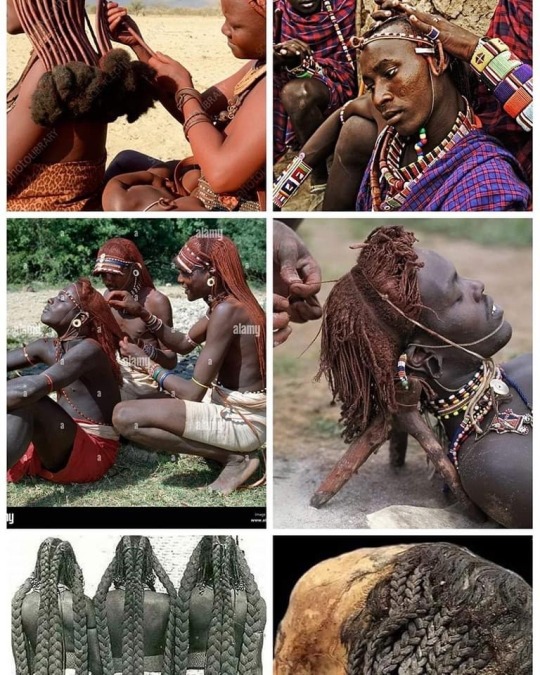
THE AFRICAN ORIGIN OF BRAIDING
The origin of braids can be traced back 5000 years in African culture to 3500 BC—they were very popular among women. Braiding started in Africa with the Himba people of Namibia. The country’s Mbalantu tribe uses eembuvi braids as an initiation into womanhood – our first examples of single braids or “box braids". In Angola, among certain tribes, hair grooming was an activity trusted only by other family members — something that women were taught at a young age and encouraged to participate in throughout their lives to promote womanhood. The origins of the ever-popular Bantu Knots have been traced to the Bantu people who exist across central and Southern Africa. “South Africa’s “Zulu Knots” are said to be the original manifestation of the style, and South Africa is also credited for the invention of “Box braids”, with evidence of the style being traced back to 3500 BCE. Braiding’s roots in East Africa have been traced back to 3500 BC, with cornrows (called Kolese braids in Yoruba) maintaining the top spot in popularity for just as long. Historically, Somali women have been recorded donning long, small braids when approaching puberty.
Ethiopia has maintained an admirably close relationship with its traditional forms of braiding. In the Southwestern Omo Valley, the Hamar tribe have perfected their hairstyles as a means to dictate male worth and female marital status. The importance of braids in communicating identity is a rich part of Uganda’s history, too. In Kenya, the Maasi and Kikuyu tribes have donned their famed matted braids, intricate beading, and gold detailings ever since. West Africa boasts an abundance of hair braiding styles, many of which have influenced global African culture and trends for decades. The Fula people, whose 30 million strong population exists across West Africa, gifted the world with Fulani braids. In Ghana, the iconic Banana or Ghana braids have gained favor for their easy application, upkeep, and excellence in providing protection to natural Black hair. The first examples of this way of braiding are traced back to hieroglyphics and sculptures found around 500 BC. Similarly, Nigeria’s rich history of braiding can be traced back to a clay sculpture dated to 500 BCE depicting a cornrowed member of the Nok tribe. Mali's Dogon tribe has various spiritual idols depicting cornrowed spiritual leaders, and the retained tradition of The Dama dance have allowed us the privilege of understanding the bewildering society that contributed to our understanding of our universe. In Sierra Leone, Mende people's hair is closely tied to femininity and is juxtaposed with the way forests grow out of the Earth – the vegetation covering Mother Earth grows skyward the way Afro-textured hair grows out of the head.
Senegal’s Senegalese Twists or “Rao” as they’re known locally came in vogue as an alternative means of creating individual, long braids – if locs or “box braids” aren’t your style. Gambian warriors were known to march off to war with tightly coiled braids, too. The Mangbetu people of the Democratic Republic of Congo, known for their practice of wrapping their skulls into a cone shape from infancy, locally referred to as “Lipombo, ” the elongated heads were then adorned with braids plaited into a crowned, basket shape called edamburu. Cameroon’s bountiful Fulani community has kept many of their hair traditions well and alive, while the region’s Bantu population participated in the popularity of the now-famed ‘Bantu knots’.
In Chad, women of the Basara Arab tribe are known for their thick, long, luscious hair – often plaited into waist-long individual braids. In Kemet around 1600 BCE, hair braiding amongst women of royalty, nobility, and concubines was adorned with gold, beads, and perfumed grease, while common folk kept to simpler styles necessary to get work done. Back in the day, braiding hair was considered a special ceremonial practice amongst Sudanese women, even holding the braiding “events” on specific days when female neighbors and friends were invited to partake.
Reference
African Tribes and the Cultural Significance of Braiding Hair". Bright Hub Education. 9 July 2011. Archived from the original on 1 September 2017. Retrieved 1 May 2018.
6 notes
·
View notes
Text
❦2024 Pinned Post❦
Please note: my blog's theme is best viewed on computers, rather than on mobile. It makes it easier to see my side pages!
If you like my writing, feel free to support me on ko-fi!
❧Basics☙
Call me Basalt, or Octo, or Basalamander, or Basa, or whatever. I don’t care. I'm currently studying music and psychology. I use they/bun/he pronouns. I'm black and bisexual, so a lot of my writing works will reference that in some capacity.
I am always open to asks or tag games! Please PLEASE send them in, as I love getting them! I promise to try and return any asks/tags that I get!
This blog is mostly safe for work, although some content might be suggestive or borderline NSFW. Please note that in this context, NSFW doesn't always refer to sexual content. Sometimes it means violence and whump. If you'd like to avoid these here, please mute the tag #shady-salamander!
That being said, this blog will post and discuss the following: gore, body horror, murder, suggestive themes, sex, religious trauma, PTSD, childhood abuse, bigotry in all forms, sexual assault, and more. Please proceed with caution, as I'll try to tag everything to my best ability. Once again, the #shady-salamander tag will be in your best interest to mute if you don't want to see such things.
This blog in general is multifandom! It mostly hosts my writing and fandom content, although there might be a few discourse posts scattered throughout. Once again, if you'd like to mute those discourse posts, then the #slippery-salamander tag is your way to go.
❧Writeblr☙
I exclusively write fantasy, although I'll occasionally dabble in science fiction as well. I'm into both fanfiction and original works. I'm in the process of rewriting some of my older fanfiction, and uploading it to my Ao3.
Unless stated otherwise, all of my original characters are dark-skinned (black or brown). No exceptions. I love watching people of color going feral and fighting against oppressive regimes. It’s the only thing I write about and always will be.
I have a page with all of my WIPs, so please check those out if you're interested in reading further!
❧Things to Note☙
I am a full and utter supporter of ACAB, BLM, and queer liberation. If you don't like that? You can fuck all the way off.
I am anti-censorship and anti-harassment. What someone writes or draws about ≠ what they believe in real life. If you can’t separate fiction from reality, then you shouldn’t be on the internet at all. However this also doesn't mean that you can't criticize portrayals in media, nor does it mean that internalized biases can't seep into works. I think it's very important to understand that just because someone creates something, doesn't always mean they support that. There's a fine line.
If you want to send me hate mail, please be more creative than racism! Send some ableism, and transphobia too please!
All dividers I use come from @/Firefly Graphics!
❧Navigation☙
My FAQ
My WIPs (it is a google doc! I find it easier to format)
My tags
❧Other Blogs☙
@the-lost-kemetic | my kemetism and witchcraft blog
@lotus-clan | my clangen project
@writeblrsupport | one of the admins
❧Other Sites☙
basalamander on Discord
Basalamander on Neocities
Basalamander on BlueSky
Basalamander on Archive of Our Own
basalamander_ on Twitter
Icon by KARKALICIOUS on Toyhouse
3 notes
·
View notes
Text
so many people are called to Kemeticism through either Anpu or Bast. it makes me wonder why this happens. either Anpu is coming to the forefront by His own means or it is the mood of the population. so i guess there could be a few possibilities…
1. our current population is obsessed with death/grimoire/the idea of being “edgy”.
2. Anpu and Bast are just the most popular because They are the most iconic, being a ‘dog’ and a cat.
3. because the original religion of the rmT kmt is dead, Anpu revives it as He does with mummification; a partial revival.
but i tend to find that people are rather shallow. kemetics tend to be so. it’s not entirely a bad thing. it’s more of a neutral thing most of the time. and not all people are like this of course. still, this leads me to believe that the reason so many people are drawn to Kemeticism through Anpu and Bast is because of the first reason perhaps mingled with the second; They are widely known, and those witches and goths out there love death, so of course they’re going to connect with a Deity whose skin is black and represents death.
these are personal thoughts. if someone reads this i want you to know: i am not talking to you
0 notes
Text
Now looking for 1 more person who would like to join the group order for one of my bronze Wepwawet statues. 🥳 I’m in the process of seeing if I can nail down an ordering date so I can set a deadline for when interested parties should aim to have the money available to send over to me. I’ll update accordingly when I’ve got a date determined. Thank you to all who have helped spread the word, we’re so nearly there in terms of having the numbers needed to proceed! 😃
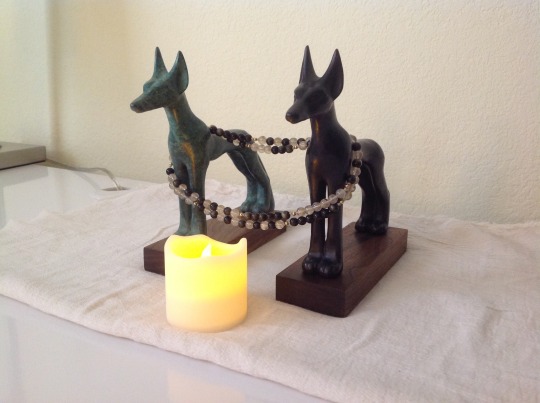
#kemetic#wepwawet#onthetemplesteps#devotional art#month of sculptural devotion#iconography#shrine icon
25 notes
·
View notes
Text
It’s a sort of small thing, as I try to reclaim myself and my faith, but I’m getting to spend time today with my Kemetic friends and family and with state icons to a few of my gods, and it’s just… so good.. I’m so glad I’m doing this. I’m glad to be here 💜
Dua Netjer!
0 notes
Text
Hi hello I'm still normal about this, so have several more images of Antinous plus more about him (because I am in fact a dweeb about this)


Antinous was a man from Bithynia, which was a province then in the Roman empire and would be located in present-day Turkey. There really isn't much known about his life aside from the fact that he was a lover to Roman Emperor Hadrian and died young, however there are speculations of events he may have experienced as documented in conjunction with Hadrian's life.
Hadrian was devestated by the loss of his lover and as such had Antinous deified, which was considerably uncommon within the Classical era for people who were not either the Emperor himself or members of the imperial family. There was actually a relatively large cult founded around him, and the deities he was associated with or the extent of his divinity varied based off of regional/localized beliefs.


Hadrian himself preferred to associate Antinous with the aspect of Hermes and even declared a temple to Hermes to the syncretised divine form Hermes-Antinous. Despite this, Antinous was most popularly associated with Dionysus, which is why the majority of the most recognized statues tend to be of Dionysus-Antinous, but he was depicted as a large variety of other popular Grecco-Roman gods, and even a couple Kemetic/Egyptian gods on occasion.
Because of his known relationship with Hadrian, he is often associated with aspects of homosexuality, and seen as a sort of icon for gay men in western culture.
Sorry for the infodump folks I'm just severely normal about Antinous (lie)
I think about the statue Antinous as Dionysus constantly, but something about it screams Ivan face claim to me like


This is just Ivan Braginsky and I refuse to be convinced otherwise
#× radio wanchii#thank you for history lession with wanchii time#this is not what the original post was about but hey more examples of antinous as refs for ivan i guess ahshshshsh
54 notes
·
View notes
Text
OPEN COMMISIONS
For Custom Woodburned Deity Icons
All Pantheons Welcome
With or Without Added Color
Free Consultations
Prices WILL VARY
Contacts:
email: [email protected]
instagram: sunshine.dedications
tumblr: buggabeewitch
OPEN COMMISSIONS
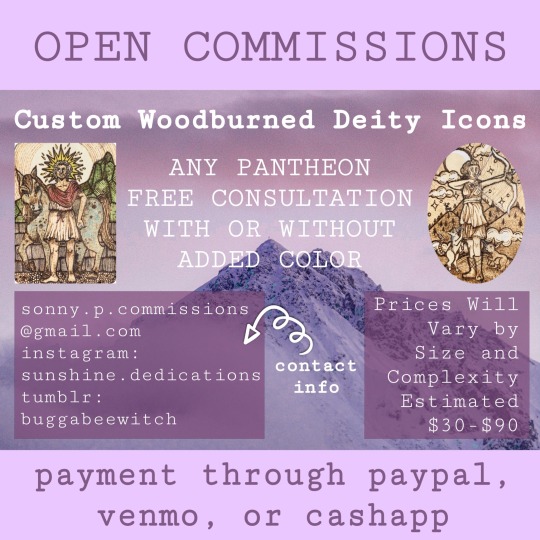
Be prepared to teach me about your Deity, at least enough to where I can appropriately represent them the way you view them and all their grace and glory.
Open to all pantheons, as well as those obscure/lesser known deities who seem to be unobtainable on Etsy and Pinterest.
Consultations are free, just shoot me a message and we’ll set up a time. I would appreciate ongoing communication throughout the process, not instantaneous responses (I understand you have a life), but do expect updates and check-ins from me as I craft your piece. Slower responses equals a longer crafting process.
Open for Art Trades as well.
Price does not include shipping. I’m offering a $10 Domestic (USA) shipping fee only (for now, at least).
Please be at least 16 if you are going to be commissioning me.
My booking fee is $20, no matter the final cost of the piece, and it will, of course, go towards the final cost. (So if I’m doing a $30 piece, you’ll pay $20 before I begin burning, and then an additional $10 when I finish. Then add shipping, an additional $10 for a total of $40). The booking fee is NOT REFUNDABLE.
OPEN COMMISSIONS
I look forward to working with you!
Sincerely,
Sonny Sunshine
(↓tags for visibility↓)
#hellenic polytheism#hellenic polytheist#hellenic gods#hellenic god#hellenic goddesses#hellenic goddess#deity icon#custom deity icon#custom woodburning#woodburning#pyrography#custom pyrography#kemeticism#kemetic religion#kemetic deity#norse religion#norse deity#deity artwork#custom deity artwork#open commissions#commissions#commissions open#my post#hellenism#helpol#religio romana#roman deity#roman pagan#hellenic pagan#norse pagan
26 notes
·
View notes
Text

Got some miniatures for my shrine in today! These gorgeous pieces are from Jacob of SonofthePharaohCA on Etsy!
#sobek#sobek-ra#sekhmet#bast#bastet#lord of the waters#lady of slaughter#mother of joy#shrine#altar#icons#kemetism#kemeticism#kemetic
4 notes
·
View notes